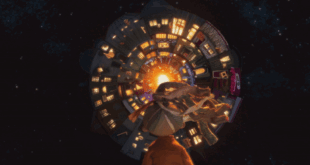Visitors to Brooklyn’s Grand Army Plaza are in for a peculiar sight. (Or not.)
For the summer, city officials have covered the Soldiers’ and Sailors’ Memorial Arch with a massive white cloak while it undergoes some much-needed repairs. The $9 million restoration of the triumphal arch and the Bailey Fountain began in early May, but only this month has the historic monument been concealed from public view. Funded by former Mayor Bill de Blasio’s administration, the project is being led by Prospect Park Alliance, a private nonprofit that oversees the park’s daily operations, in partnership with the City of New York.
Perched on the northern corner of the park at the cross-section of Flatbush Avenue and Eastern Parkway, Grand Army Plaza is more than just a busy traffic circle, playing host to countless community gatherings, protests, and events, including the year-round weekly farmer’s market.
Since the mid-1990s, when the archway was last restored, the designated landmark has fallen into serious disrepair, plagued by invasive plants and degrading infrastructure. The project to revamp the Brooklyn site was pushed back due to “project complexities” and pandemic slowdown, a Prospect Park Alliance representative told Hyperallergic; now, the restoration is forging ahead.
The project is making several improvements to the oval-shaped plaza, including the refurbishment of the arch’s brick and stone exterior, fixing the monument’s interior staircases leading to the observation deck, and the replacement of the archway’s roof and outside light fixtures.

Additionally, the plaza’s existing chain link fence will be switched out for new steel barriers, and the broken, uneven walkways leading to the historic Bailey Fountain and the John F. Kennedy Memorial will be repaired to improve pedestrian accessibility. The project will also tend to the grassy embankments framing the plaza, as the City plans to remove invasive plants and trees in poor health, and repopulate the landscape with fresh native flora.

Before the traffic circle existed, the area was originally the site of the Battle of Long Island (or the Battle of Brooklyn) in the Revolutionary War, the first major battle after the signing of the Declaration of Independence. During the construction of Prospect Park in 1867, park creators Frederick Law Olmsted and Calvert Vaux designed the elliptical plaza as a formal entrance to the park. The plaza became the location for the Soldiers’ and Sailors’ Memorial Arch in 1892. Designed by John H. Duncan, the granite monument was erected to honor those who served and fought in the Union Army during the Civil War.
The tall archway is decorated with bronze statuary groupings designed by Frederick MacMonnies that depict the goddess Columbia, a feminine personification of America riding in a horse-drawn chariot, and Union Army soldiers and sailors who fought in the Civil War. In the statuary group on the right, a Black male soldier is depicted holding a pistol, crouching in front of the White soldiers standing behind him.
The Black soldier’s kneeling pose has been the subject of criticism and debate, explained University of Pittsburgh Professor Kirk Savage, who told Hyperallergic that the image comes from 19th-century abolitionist White savior emblems that “completely lacked any notion of Black agency or resistance.” As a professor in art history and architecture, Savage focuses his research on Civil War monuments and currently sits on the Board of Directors for Monument Lab, a Philadelphia nonprofit specifically aimed at the reformation of past, present, and future public monuments.

Savage explained that even though the figure is “partially stuck in the passive pose of a kneeling figure,” the inclusion of the bronze soldier was “a groundbreaking image” for its time, as it illustrated “some agency or resistance” that was otherwise absent in other abolitionist-influenced Civil War monuments at the time. Savage noted the sculptor’s specific decision to put a pistol in the soldier’s hand, as well as to have the soldier’s gaze looking outward in the same direction of the cannon at his side, unlike other memorials from the time such as Thomas Ball’s “Emancipation Group” (1873) that showed Black individuals looking downward in a submissive pose.
New York City had its own problematic history during the Civil War. Despite being a Union state, the city inflicted its own violence against its Black residents, such as the 1863 draft riots when angry White residents carried out five days of “acts of terror” against the city’s Black population on a massive scale, Savage explained.
“To put a Black figure in this monument at all was something that I think was surprising,” Savage said. “But there’s still probably space for a counter image to [the arch] that better represents the long history of Black resistance.”
Multimedia artist Nicole Awai explained to Hyperallergic how she has always viewed the Black soldier in the monument as her “guide,” helping inspire her multimedia installation “Persistent Resistance of the Liquid Land” (2018) at the BRIC art center in Downtown Brooklyn. The image of the soldier also prompted Awai to create “Spirit of Persistence of Resistance of the Liquid Land” (2018) in response to the removal of Confederate monuments across the country, commemorating the fatal 2017 white supremacist Unite the Right rally in Charlottesville, Virginia that resulted in the killing of civil rights activist Heather Heyer.
“He is never a victim. For me, he was truly the alchemist, the person who transforms or creates through a seemingly magical process, who has the power to transform things for the better,” Awai said.
Construction on the Soldiers’ and Sailors’ Memorial Arch is set to wrap by this fall. The arch and oval-shaped plaza will reopen to pedestrians by spring of 2024.
Source link

